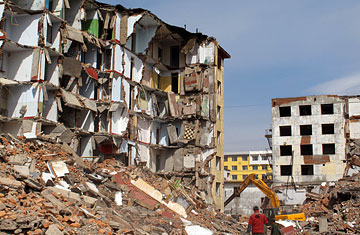
Workers tear down old buildings at a construction site in Jilin, China, on April 4, 2010
The Avenue of Eternal Peace in downtown Beijing has an increasingly transient facade. Earlier this month, construction workers on the avenue quietly dismantled an 18-story building, once a proud landmark just a few blocks east of the city's geographic center. Built in 1990, the Gloria Plaza Hotel had "lagged behind the progress of society," reported the state media, and it will soon be replaced by a bigger five-star hotel with a more cosmopolitan vibe.
The ever changing urban landscape has become a common scene in many Chinese cities. According to the Ministry of Housing and Urban-Rural Development, China is constructing more than 21.5 billion sq. ft. (2 billion sq m) of new property every year, gobbling up some 40% of the world's total cement and steel production for buildings whose average lifespan is estimated at only 25 years to 30 years, despite the fact that Chinese law requires them to last for 50 years to 100 years. "These figures should definitely raise a red flag," says Zheng Shiling, a professor of architecture at Tongji University in Shanghai. "Clearly, many of those buildings didn't have to be replaced because of their bad quality, but rather owing to a prevalent mind-set among decisionmakers that new things are always better than the old."
Tearing down buildings before their time has a long history in China. During the mayhem of the Cultural Revolution, countless historic buildings, including the oldest temple of Confucius, were destroyed as Red Guards declared their relentless disdain for the past. "Whenever a new emperor was enthroned, he would try to wipe out all remnants of previous dynasties," Zhuang Weimin, director of the Architectural Design and Research Institute at Beijing's Tsinghua University, recently told the state-run People's Daily. "This kind of belief still very much influences our government officials today."
That doesn't mean it's convenient. Earlier this year, the local government of an impoverished county in eastern China's Anhui province ignited nationwide criticism when officials authorized the bulldozing of large swaths of residential areas to make room for its new administrative building, which will cost $15 million to construct. In another case, the government of Chengdu, the capital of Sichuan province, caused a huge backlash by moving into a new $180 million office building three days after the deadly earthquake in 2008 that took at least 68,000 lives, with many dying when shoddy buildings collapsed. Under pressure, the local government soon announced its plan to sell the building, though no evidence has yet shown that the deal actually went through.
Meanwhile, China's skyrocketing housing prices have spurred on the construction industry, which is growing in revenue at an annual rate of 18%, thanks in part to the $586 billion stimulus package that the government announced in late 2008. Experts worry that such opportunities to cash in on real estate will give rise to rickety construction projects and badly designed urban planning. "A few decades ago, our [country's] main concern was still to provide shelters for people as quickly as possible, and that had created lots of poor-quality buildings," says Zheng. "But things have been very different in recent years. We've seen more relentless developers who would do anything to maximize profits, even if that means compromising the quality of buildings."
In fact, building quality has come to be an increasingly prominent concern since a large number of schools were shattered during the Sichuan earthquake, killing 5,335 students, according to the official tally. A much publicized accident took place last year in Shanghai, when an almost completed residential building toppled over on its side and killed a construction worker. Six people were sentenced to prison for violation of safety-management regulations that led to the building's collapse. A few months later, a six-story apartment building collapsed in Wuhan, Hubei province. Investigations in that case exposed a flimsy skeleton of iron wires being used instead of steel to hold together the building.
To prolong the lives of Chinese buildings, Zheng says the main obstacle is overcoming the predominant new-trumps-old mind-set, a goal that he thinks is achievable with the help of government support. "In the past, we didn't make it a priority to protect old buildings, or to reduce energy consumption and waste," he says. "Now we should really focus on how to make them both more durable and timeless in style."
